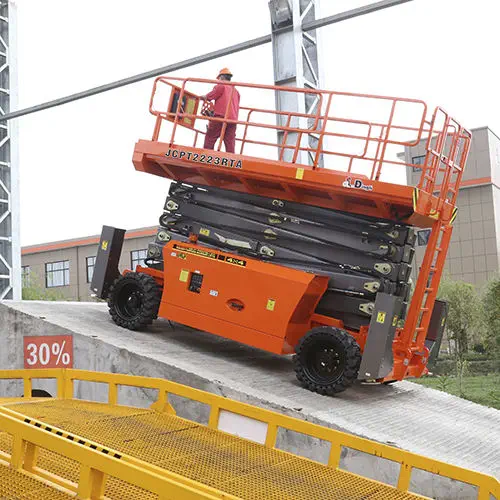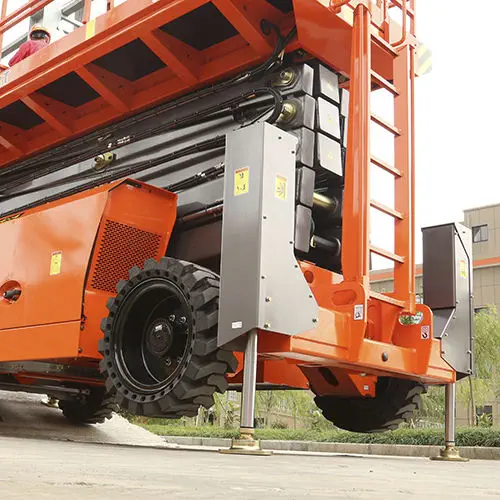Safety Tips for Using a Scissor Lift on a Slope or Incline
Operating a scissor lift on a slope presents unique challenges that require careful attention to safety protocols.
Whether you’re in construction, maintenance, or another industry where scissor lifts are commonly used, understanding how to navigate slopes safely is crucial for preventing accidents and injuries.
In this post, we’ll showcase elevating work platform units that are specifically designed to operate on slopes and inclines whilst also discussing some essential safety tips for safe operation.
Types of Scissor Lifts that can Operate on a Slope or Incline
Standard electric scissor lifts are designed to be safely operated on firm level surfaces.
The lift can only function on level ground making the unit inoperable on inclines with the platform unable to be raised.
Rough terrain or track driven scissor lifts have been specifically engineered to be able to drive across rough and undulating terrains with in-built 4WD capabilities offering superior manoeuvrability.
These lifts will still require a firm stable surface to support the outriggers or tracks for elevation but are able to operate on inclines and slopes up t to 20 degrees depending on the specific model.
Scissor Lifts with Stabilisers / Outriggers
Scissor lifts fitted with deployable stabilisers or outriggers secure the unit on inclines, keeping the base level whilst the platform is elevated and work is carried out.
Rough Terrain Scissor Lifts like the SC1218-AWD Scissor lift from Dingli are fitted with outriggers that allow the unit to safely lift a maximum 454kg load limit up to 12m on a working slop of up to 1.5 degrees.

Track Diven Scissor Lifts
Another scissor lift variant suitable for safely operating on slopes and inclines are track driven units like the 870-BL model from Athena.
The unit is the first of its kind to offer proactive and dynamic leveling that allows the unit to instinctively and automatically level in either the stowed or raised position allowing the unit to operate on working slopes and inclines up to 15 degrees.
Need to Rent a Scissor Lift? View our complete range of rental scissor lifts
7 Safety Tips for Operating a Scissor Lift on a Slope or Incline
1. Conduct a Pre-Operational Inspection
Before operating a scissor lift on a slope, thoroughly inspect the equipment to ensure it’s in proper working condition. Check for any signs of damage, hydraulic leaks, or worn-out parts. In Australia, workplace health and safety regulations, such as those outlined by Safe Work Australia, mandate regular equipment inspections to identify and address potential hazards.
2. Check the Slope Gradient
Evaluate the slope gradient to determine if it’s safe for operating a scissor lift. Refer to the lifts manufacturers manual, for guidelines on the maximum allowable slope gradients for the scissor lift. Avoid operating on slopes exceeding the recommended limits to prevent instability and tip-over accidents.
To assist with safety all scissor lifts are fitted with level sensors that will sound an audible alarm and prevent the platform from being raised if the unit is not level or exceeds its allowable slope gradients.
3. Engage Stabilizers and Brakes
Before ascending or descending a slope, engage the scissor lift’s stabilisers to enhance stability. Ensure that the brakes are in good working condition and properly engaged to prevent unintended movement. Australian workplace safety regulations emphasize the importance of using safety devices, such as stabilizers and brakes, to minimize risks associated with operating machinery on slopes.

4. Maintain Proper Load Distribution
Distribute the load evenly on the scissor lift platform to maintain balance, especially when operating on a slope. Avoid exceeding the lift’s maximum load capacity, as specified by the manufacturer. Australian Work Health and Safety Regulations require employers to ensure that loads are securely positioned and within safe limits to prevent overloading incidents.
5. Use Proper Driving Techniques
When manoeuvring a scissor lift on a slope, use caution and employ proper driving techniques. Slow down and maintain a steady speed to prevent sudden movements that could lead to loss of control. Be mindful of potential hazards, such as uneven terrain or obstacles, and adjust your driving accordingly. Australian training programs, such as those offered by Registered Training Organizations (RTOs) accredited by the Australian Skills Quality Authority (ASQA), provide comprehensive instruction on safe driving practices for operating scissor lifts.
6. Monitor Weather Conditions
Be aware of weather conditions that could affect the stability and safety of operating a scissor lift on a slope. In Australia, where weather patterns can be unpredictable, factors such as high winds or heavy rain may pose additional risks. Refer to local weather forecasts and adhere to relevant safety guidelines, including those outlined by government agencies such as Safe Work Australia.
7. Receive Proper Training
Ensure that operators receive adequate training and certification before operating a scissor lift on slopes. Australian regulations mandate that employers provide comprehensive training programs that cover safe operating procedures, hazard identification, emergency protocols, and equipment maintenance. By investing in proper training, employers can mitigate risks and promote a culture of safety in the workplace.

In conclusion, operating a scissor lift on a slope requires careful planning, adherence to safety regulations, and diligent attention to operational procedures.
By following these essential safety tips workers can minimise the risks associated with working at heights and ensure a safe and productive work environment.
Remember, safety is everyone’s responsibility, and prioritizing it is key to preventing accidents and protecting lives in the workplace.
Unsure of which scissor lift is suitable for your job contact our Access equipment specialists on 13 22 54 for a recommendation.